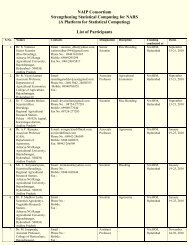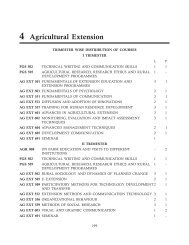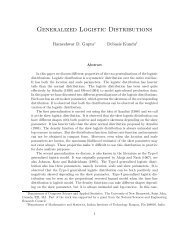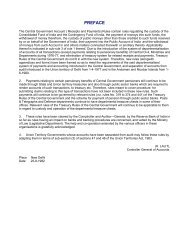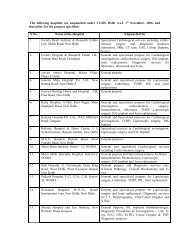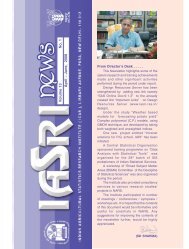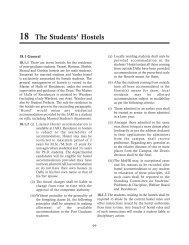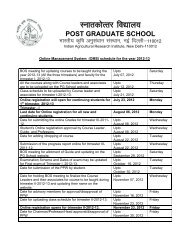Education and Training - IASRI
Education and Training - IASRI
Education and Training - IASRI
Create successful ePaper yourself
Turn your PDF publications into a flip-book with our unique Google optimized e-Paper software.
<strong>Education</strong> <strong>and</strong> <strong>Training</strong><br />
DEGREE COURSES<br />
The Institute continued to conduct the following degree<br />
courses in collaboration with the Post Graduate School<br />
of Indian Agricultural Research Institute (IARI) which<br />
has the status of a Deemed University:<br />
(i) Ph.D. (Agricultural Statistics)<br />
(ii) M.Sc. (Agricultural Statistics)<br />
(iii) M.Sc. (Computer Application)<br />
Both Ph.D. <strong>and</strong> M.Sc. students are required to study<br />
courses not only in Agricultural Statistics but also in<br />
Agricultural Sciences like Genetics, Agronomy,<br />
Agricultural Economics, etc. The courses in<br />
Mathematics, Agricultural Statistics <strong>and</strong> Computer<br />
Application are offered at this Institute while the courses<br />
in Agricultural Sciences are offered at IARI.<br />
The eligibility qualification for admission to Master’s<br />
degree in Agricultural Statistics is a Bachelor’s degree<br />
with atleast 60% marks or its equivalent overall grade<br />
point average (OGPA) in Agriculture/Horticulture/<br />
Forestry/Agroforestry/Sericulture/Agricultural<br />
Marketing/B.Sc. (10+2+3 System). For admission to<br />
Master’s degree in Computer Application, the eligibility<br />
qualification is a Bachelor’s degree with atleast 60%<br />
marks or its equivalent overall grade point average<br />
(OGPA) in Agriculture/Computer Science/Agricultural<br />
Engineering/B.Sc. (Horticulture), Veterinary Science,<br />
Home Science, B.Sc. (Forestry)/B.Sc. with Maths./<br />
Statistics/Physics/Biology/B.Sc. (10+2+3 System).<br />
Further, for admission to Doctor’s degree in Agricultural<br />
Statistics, the eligibility qualification is a Master’s degree<br />
with atleast 60% marks or its equivalent overall grade<br />
point average (OGPA) in Agricultural Statistics/Statistics/<br />
Mathematical Statistics/Bio-Statistics of IVRI/<br />
Professional Statisticians’ Certificate Course (PSCC)<br />
from <strong>IASRI</strong>.<br />
Number of students admitted/completed various<br />
courses are:
<strong>Education</strong> <strong>and</strong> <strong>Training</strong><br />
(a) Ph.D. (Agricultural Statistics)<br />
Admitted : 5<br />
Completed : 3<br />
(b) M.Sc. (Agricultural Statistics)<br />
Admitted : 6<br />
Completed : 5<br />
(c) M.Sc. (Computer Application)<br />
Admitted : 8<br />
Completed : 1<br />
Brief of work done by students completed various<br />
courses during 2008-09 is as follows:<br />
Ph.D. (Agricultural Statistics)<br />
i) Susheel Kumar Sarkar<br />
Computer aided search of linear trend free<br />
multifactor designs<br />
Designs for factorial experiments have been widely used<br />
in agricultural, biological <strong>and</strong> industrial experiments. The<br />
experimental units in a design of a factorial experiment<br />
may exhibit a trend over space or time. Such situations<br />
may occur in agricultural experiments when there is a<br />
slope in the field <strong>and</strong> there is sequential application of<br />
the treatments to the same experimental unit over time<br />
periods. This may also happen when the l<strong>and</strong> is irrigated,<br />
the nutrients supplied by the fertilizers may not be<br />
equally distributed <strong>and</strong> trend in experimental units may<br />
be due to slope. In such situations, a common<br />
polynomial trend within experimental units may occur.<br />
In factorial experiments the interest of the experimenter<br />
is in the estimation of main effects, two-factor<br />
interactions, three-factor interactions, <strong>and</strong> so on <strong>and</strong><br />
testing the hypothesis with respect to these effects. In<br />
the presence of trends among the experimental units, it<br />
may be desirable to estimate the main effects <strong>and</strong><br />
interactions of interest free from trend effects. The trend<br />
may be represented by a polynomial of appropriate<br />
degree smaller than the block size minus one. Generally,<br />
we consider the presence of a linear trend among the<br />
experimental units within a block. In the presence of<br />
linear trends among the experimental units within a block<br />
of a factorial experiment, it is desired to allocate the<br />
treatment combinations to experimental units such that<br />
the main effects <strong>and</strong> interactions of interest are<br />
estimated free from the trend effects. In other words,<br />
the estimates of the main effects <strong>and</strong> the interactions of<br />
interest are orthogonal to linear trend effects. Such<br />
designs are called as linear trend-free designs for<br />
factorial experiments for estimating the effects of interest<br />
<strong>and</strong> the ordered application of treatments to<br />
experimental units is called run order.<br />
This research work is devoted to the development of<br />
computer algorithms for construction of trend-free<br />
designs for multifactor experimental settings. The<br />
algorithms developed are helpful in generating the<br />
complete <strong>and</strong> confounded factorial experiments that<br />
are linear trend-free for main effects. A search has been<br />
made to identify the two <strong>and</strong> three factor interactions<br />
that are estimable free or nearly free from linear trend<br />
effect. The algorithms are developed using the criterion<br />
of component-wise product. This algorithm has been<br />
translated in Microsoft Visual C++ program. From this<br />
program, one can obtain the design for factorial<br />
experiment for any number of factors k (≥ 3) each at<br />
two levels. The catalogue of the obtained designs for<br />
k<br />
2 factorial experiment (k = 3, …, 7) that are linear<br />
trend-free for main effects along with two <strong>and</strong> three<br />
factor interactions has been given for complete <strong>and</strong><br />
confounded factorial experiments, separately.<br />
Algorithms have been developed to obtain fractional<br />
factorial plans that are linear trend-free for main effects<br />
<strong>and</strong> to identify two factor interactions that are linear<br />
trend-free/ nearly linear trend-free using the criterion of<br />
complement foldover. Algorithm has also been<br />
developed to obtain computer aided linear trend-free<br />
Box-Behnken response surface designs with the help<br />
of a given BIB design. The catalogue for fractional<br />
factorial plans for k = 5 to 8 factors each at 2 levels <strong>and</strong><br />
for linear trend-free Box-Behnken response surface<br />
designs for k taking values as 2, 3, 4 <strong>and</strong> 5 has been<br />
prepared.<br />
Guide: Dr. Krishan Lal<br />
ii) Nishanti Rupika Abeynayake (Foreign student<br />
from Sri Lanka)<br />
A study on neighbour-balanced designs<br />
Neighbour-balanced designs, wherein the allocation of<br />
treatments is such that every treatment occurs equally<br />
often with every other treatment as neighbours, are used<br />
when the treatment applied to one experimental plot<br />
may affect the response on neighbouring plots besides<br />
the response to which it is applied. These designs<br />
ensure that no treatment is unduly disadvantaged by<br />
its neighbours <strong>and</strong> help in estimating the neighbour<br />
40
<strong>Education</strong> <strong>and</strong> <strong>Training</strong><br />
effects besides the direct effects of treatments. Under<br />
the Neighbour Balanced Block (NBB) design setting, it<br />
may sometimes be desired to compare a set of test<br />
treatments with a control or a set of controls. The main<br />
interest here is to estimate the contrasts pertaining to<br />
tests (with respect to direct <strong>and</strong> neighbours) versus<br />
control(s) with high precision. Some series of NBB<br />
(complete <strong>and</strong> incomplete) designs for comparing a set<br />
of test treatments to control(s) have been developed.<br />
The information matrix for estimating direct effects, left<br />
<strong>and</strong> right neighbour effects for all these class of designs<br />
have been derived. The designs obtained are totally<br />
balanced in the sense that all the contrasts among test<br />
treatments for direct effects, left <strong>and</strong> right neighbour <strong>and</strong><br />
all the contrasts pertaining to test versus control effects<br />
are estimated with same variance. In experimentation<br />
using NBB designs, there may arise the possibility that<br />
some of the observations could become unavailable for<br />
analysis. The robustness of NBB designs have<br />
been examined against missing observation(s). The<br />
information matrix for estimating direct treatment effects<br />
of the resultant design under one-sided neighbour<br />
effects model against a missing observation from the<br />
last plot of a block has been derived <strong>and</strong> the efficiency<br />
of resulting design is investigated. Robustness of various<br />
classes of NBB designs under one-sided <strong>and</strong> two-sided<br />
neighbour model, with complete <strong>and</strong> incomplete blocks<br />
have been studied against missing observation(s) <strong>and</strong><br />
the efficiency of these designs have been calculated.<br />
The NBB designs are found to be robust/fairly robust<br />
against missing of observations for number of<br />
treatments more than 5. NBB designs have also been<br />
studied when the treatment form a factorial structure.<br />
Complete NBB designs <strong>and</strong> incomplete partially NBB<br />
designs for two factors have been constructed that are<br />
balanced for one factor.<br />
Guide: Dr. Seema Jaggi<br />
iii) Ranjit Kumar Paul<br />
A study of some parametric <strong>and</strong> nonparametric<br />
approaches for nonlinear time-series models<br />
The basic concepts of various statistical modelling<br />
techniques are introduced, Generalized autoregressive<br />
conditional heteroscedastic (GARCH) nonlinear timeseries<br />
model along with its estimation procedures are<br />
thoroughly studied. As an illustration, autoregressive<br />
integrated moving average (ARIMA) <strong>and</strong> GARCH<br />
models are employed for modelling <strong>and</strong> forecasting of<br />
all-India export data of spices. Superiority of GARCH<br />
model over ARIMA approach is demonstrated for the<br />
data under consideration. A very important extension<br />
of GARCH model, viz. Exponential GARCH (EGARCH)<br />
model is thoroughly studied. A heartening feature of this<br />
model is that, it is capable of describing asymmetric<br />
volatility present in the data sets. Procedure for<br />
estimation of parameters of this model is also discussed.<br />
As an illustration, GARCH <strong>and</strong> EGARCH models are<br />
applied for modelling <strong>and</strong> forecasting of all-India monthly<br />
export data of fruits <strong>and</strong> vegetables seeds. It is<br />
concluded that, for data set under consideration,<br />
EGARCH model has performed better than GARCH<br />
model for both modelling <strong>and</strong> forecasting purposes.<br />
For periodic <strong>and</strong> ARCH effects, best predictor <strong>and</strong><br />
prediction error variance for carrying out out-of-sample<br />
forecasting up to three-steps ahead are derived<br />
analytically by recursive use of conditional expectation<br />
<strong>and</strong> conditional variance. As an illustration, modelling<br />
<strong>and</strong> forecasting of monthly rainfall data of Sub-<br />
Himalayan West Bengal meteorological subdivision,<br />
India is carried out. The study reveals that for the data<br />
under consideration, the Periodic autoregressive (PAR)<br />
model with AR-GARCH errors has performed better than<br />
the Seasonal ARIMA (SARIMA) model for modelling as<br />
well as forecasting. The powerful methodology of<br />
“Wavelet analysis in frequency domain” is studied for<br />
analyzing time-series data. The procedure for<br />
estimating the trend <strong>and</strong> modelling of time-series data<br />
through generation of long memory process by Haar<br />
<strong>and</strong> Daubechies (D4) wavelets is thoroughly discussed.<br />
As an illustration, Indian monsoon rainfall time-series<br />
data is considered. The discrete wavelet transform<br />
(DWT) <strong>and</strong> multiresolution analysis (MRA) of the data<br />
are computed <strong>and</strong> behaviour at different scales is<br />
analyzed. By using bootstrap method, size <strong>and</strong> power<br />
of the test for testing significance of trend in the data is<br />
computed. It is concluded that there is a declining trend<br />
in the Indian monsoon rainfall data. This feature,<br />
however, is not able to be captured by ARIMA approach.<br />
Finally, a very versatile nonparametric nonlinear timeseries<br />
model, viz. Functional-coefficient autoregressive<br />
(FAR) model, in which the coefficient function changes<br />
gradually rather than abruptly, is investigated. This<br />
model is applied to India’s annual export lac data during<br />
the period 1900 to 2000. Superiority of FAR model over<br />
Self exciting threshold autoregressive (SETAR) model<br />
<strong>and</strong> ARIMA approaches is demonstrated for the data<br />
under consideration.<br />
Guide: Dr. Prajneshu<br />
41
<strong>Education</strong> <strong>and</strong> <strong>Training</strong><br />
M.Sc. (Agricultural Statistics)<br />
i) Sanjay Kumar Prasad<br />
A study on Bayesian analytical techniques for<br />
experimental data<br />
A Bayesian approach to a problem starts with the<br />
formulation of a model that is adequate to describe the<br />
situation of interest. Then a prior distribution over the<br />
unknown parameters of the model is formulated, which<br />
is meant to capture our beliefs about the situation before<br />
seeing the data. After observing some data, Bayes’ Rule<br />
is applied to obtain a posterior distribution for these<br />
unknowns, which takes account of both the prior <strong>and</strong><br />
the data. Bayes’ statistics is now rapidly becoming<br />
accepted as a way to solve applied statistical problems<br />
<strong>and</strong> has several special features which combine to make<br />
it appealing for solving applied problems. In recent times,<br />
Bayesian methods are being widely used in designed<br />
experiments.The present thesis deals with the<br />
development of Bayesian methods of analysis of block<br />
designs. In literature, there are several distributions<br />
available which can be taken as a form of prior<br />
information. Out of the available distributions which can<br />
approximate the prior information are divided into two<br />
categories namely conjugate <strong>and</strong> non-conjugate family.<br />
Both the categories of distributions have been<br />
considered. Under conjugate family we have considered<br />
Normal-Gamma <strong>and</strong> Normal-Chi density for<br />
approximating the factors contributing for block design<br />
<strong>and</strong> variance parameter respectively. In case of nonconjugate<br />
family, distributions considered are as<br />
Multivariate–t <strong>and</strong> Gamma for assignable <strong>and</strong> nonassignable<br />
causes have been considered respectively.<br />
The developed procedures have been applied to a real<br />
experimental data set pertaining to Long-Term Fertilizer<br />
Experiments conducted at Ranchi under the aegis<br />
of AICRP on LTFE. It was observed that some of<br />
the treatment pairs which are not significant in<br />
classical analysis become significant after Bayesian<br />
analysis of the same set of data with the use of<br />
respective prior information. It is also found that in some<br />
of the cases block effects become significant after<br />
applying the Bayesian method. The Bayesian analysis<br />
with non-conjugate prior pose the problem of high<br />
dimensionality <strong>and</strong> complexity in integration <strong>and</strong> is<br />
solved by using Gibbs sampling (MCMC method)<br />
technique.<br />
Guide: Dr. L.M. Bhar<br />
ii) Kaustav Aditya<br />
Forecasting of crop yield using discriminant<br />
function technique<br />
In the present study wheat crop yield forecast models<br />
for Kanpur district of Uttar Pradesh have been<br />
developed using weekly data on the weather variables<br />
such as maximum temperature, minimum temperature,<br />
rainfall <strong>and</strong> morning relative humidity. Discriminant<br />
function technique has been used for developing the<br />
forecast models. Crop yield forecast models have been<br />
developed taking the discriminant scores <strong>and</strong> trend<br />
variable as regressors <strong>and</strong> crop yield as the dependent<br />
variable. Variables (weather indices) used in the<br />
discriminant function analysis were derived through<br />
different procedures. Evaluation of the performance of<br />
the models developed using the various procedures is<br />
done by comparing the Percentage Deviations of<br />
forecasts obtained from various models with the<br />
observed yield, Percent St<strong>and</strong>ard Error (PSE), Root<br />
Mean Square Deviation (RMSE) etc. Using these<br />
criteria, the model which came out to be most suitable<br />
for forecasting is based on the discriminant function<br />
approach. In this approach, two discriminant scores<br />
have been calculated by taking the data of the weather<br />
variables of the first week. Then taking these two scores<br />
<strong>and</strong> the weather data of the second week again two<br />
scores have been obtained. This procedure is repeated<br />
till the last week <strong>and</strong> finally two scores have been<br />
obtained. Then taking these two scores <strong>and</strong> trend<br />
variable as the regressors, forecast regression model<br />
has been fitted. This procedure gave minimum root<br />
mean square error among all procedures studied.<br />
Thus, this procedure can be used as the most suitable<br />
procedure for forecasting of wheat yield for Kanpur<br />
district of Uttar Pradesh.<br />
Guide: Dr. Ranjana Agrawal<br />
iii) Bishal Gurung<br />
Construction of supersaturated designs<br />
In factorial experiments, if the number of factors is large<br />
the number of treatment combinations becomes very<br />
large. While experimenting with such large number of<br />
factors, many difficulties are encountered. In such<br />
studies ‘complete’ factorial is not necessary as the<br />
interest is generally not in ‘higher order interactions’.<br />
The experimenter’s endeavour is to minimize the<br />
number of runs to identify the active factors for efficient<br />
42
<strong>Education</strong> <strong>and</strong> <strong>Training</strong><br />
utilization of resources <strong>and</strong> minimization of cost <strong>and</strong><br />
time. In the event of large number of factors, one may<br />
opt for Supersaturated design (SSD) where the number<br />
of factors(parameters) is very large compared to the<br />
number of experiments (runs) to be conducted.<br />
Here non-orthogonality is introduced in the design, i.e.,<br />
the parameters to be estimated are not done<br />
independently because of the lesser number of runs<br />
compared to the number of factors to be estimated. The<br />
experimenter’s endeavour is to minimise this nonorthogonality<br />
as much as possible. Hence with this<br />
motivation, we have proposed a new procedure of<br />
computer aided r<strong>and</strong>om generation of multi-level as well<br />
as mixed-level SSDs. A catalogue of designs generated<br />
from the algorithm is also prepared. The proposed<br />
method is also compared with the existing designs. The<br />
new method proposed is an attempt to make the SSDs<br />
with less departure from orthogonality. Further, the<br />
designs constructed are evaluated to see the utility of<br />
the proposed methods.<br />
Guide: Dr. L.M. Bhar<br />
IV) Sukanta Dash<br />
Some investigations on classificatory techniques<br />
in agriculture<br />
The present investigation has been conducted to explore<br />
Artificial Neural Network (ANN) methodology for<br />
classification of crop genotypes <strong>and</strong> to compare it with<br />
classical clustering methods based on different distance<br />
measures. The secondary data of ten morphological<br />
characters consisting of seventy seven genotype of<br />
maize crop collected from All India Coordinated Maize<br />
Improvement Project for the year 2005-06 has been<br />
used. The seventy seven genotypes of maize were<br />
clustered using different classical methods such as<br />
single linkage, average-between linkage, average-within<br />
linkage, Ward’s method <strong>and</strong> non-hierarchical K-means<br />
method. The five homogeneous groups so obtained from<br />
consensus basis were tested for their significant<br />
difference using Hotelling’s T 2 statistic. Since some of<br />
the grouped pairs were non significant, the data were<br />
reclassified by considering four <strong>and</strong> three homogeneous<br />
groups. Ultimately three significantly different<br />
homogeneous groups were obtained.<br />
Taking the mean vector <strong>and</strong> dispersion matrix of three<br />
distinct homogeneous groups, the multivariate normal<br />
samples of different sample sizes were obtained with<br />
prior knowledge of cluster identity. These samples were<br />
classified using different classical clustering methods<br />
<strong>and</strong> distance measures as well as ANN method. All the<br />
methods were compared by the probability<br />
misclassification. From the methods studied, ANN is<br />
the best method of classification as it gives minimum<br />
probability of misclassification irrespective of distance<br />
measures used in classical clustering methods <strong>and</strong><br />
sample sizes. The second best method is nonhierarchical<br />
K-means method as it gives less probability<br />
of misclassification as compared to hierarchical methods<br />
irrespective of distance measures in case of medium<br />
<strong>and</strong> large sample sizes. In case of small sample size,<br />
Ward’s method with square Euclidean distance is the<br />
second best next to ANN as compared to the remaining<br />
classical methods.<br />
Guide: Sh. S.D. Wahi<br />
V) Manoj Kumar<br />
A study on development indices <strong>and</strong> their<br />
sensitivity analysis<br />
Development is a multi-dimensional process <strong>and</strong> its<br />
impact cannot be captured fully by any single indicator.<br />
An indicator is a quantitative or a qualitative measure<br />
derived from a series of observed facts that reveal<br />
relative positions in a given area. A composite index is<br />
useful in identifying trends <strong>and</strong> drawing attention to<br />
particular issues in the context of policy analysis. There<br />
are several methods of construction of composite index<br />
but they have certain limitations. Therefore, in this study,<br />
an attempt was made to review the methodological<br />
issues for the construction of composite index.<br />
Agricultural Development Index (ADI) of Bihar State has<br />
been constructed using Principal Component Analysis<br />
(PCA). The performance of the districts has been<br />
compared based on these developed indices. The<br />
categorization of developed indices has also been done.<br />
An attempt has also been made to generate thematic<br />
maps of Bihar based on the Agricultural Development<br />
Index <strong>and</strong> its sub indices like Input, Output <strong>and</strong><br />
Infrastructure index using Geographical Information<br />
System (GIS). The GIS software has been used in<br />
generating suitable thematic maps depicting the level<br />
of development of each district. Sensitivity analysis of<br />
the developed indices have been carried out using<br />
empirical method of variance-based technique <strong>and</strong> also<br />
by using a software namely, SIMLAB, that is especially<br />
designed for sensitivity analysis. Sensitivity analysis of<br />
the Agricultural Development Index over input, output<br />
<strong>and</strong> infrastructure indices <strong>and</strong> sensitivity analysis of sub-<br />
43
<strong>Education</strong> <strong>and</strong> <strong>Training</strong><br />
indices over their variables (available secondary data)<br />
have been carried out using both the approaches. The<br />
results of sensitivity analysis using empirical method of<br />
variance-based technique have been compared with<br />
the results obtained using SIMLAB software.<br />
Guide: Dr. Tauqueer Ahmad<br />
M.Sc. (Computer Application)<br />
i) Ramdasi Sanmit Suresh<br />
Design & development of data marts for household<br />
amenities from census data (Maharashtra)<br />
The first <strong>and</strong> foremost need for developing a decision<br />
support system on agriculture resources is to integrate<br />
the scattered historical information which is spread<br />
across the nation into a central data warehouse.<br />
Keeping the above need in mind the available data from<br />
census of India 2001, regarding the Household<br />
Amenities in Maharashtra State have been analyzed to<br />
identify possible data marts <strong>and</strong> the dimensions that<br />
can be associated with these data marts. To find out<br />
the associated dimensions with the data marts <strong>and</strong><br />
conformed dimensions, the top-down planning<br />
approach called as Data Warehouse Bus Architecture<br />
Matrix was used. With the help of this matrix the<br />
dimensional models have been designed <strong>and</strong> subject<br />
wise data marts have been created. The data storage<br />
has been converted into a form of multidimensional<br />
model, known as cube. These cubes have been<br />
designed by using fact <strong>and</strong> dimension tables <strong>and</strong><br />
deployed on Internet for on-line analysis, which is called<br />
as On-Line Analytical Processing (OLAP). The data in<br />
the developed cubes can be viewed in cross tab view<br />
as well as graphical views including simple bar graph,<br />
pie chart, clustered bar graph, stacked bar graph,<br />
multiline graph, three dimensional bar graph etc. Drill<br />
downs <strong>and</strong> roll ups can be performed on the data<br />
available in the cubes. Another important functionality<br />
incorporated in these cubes is Drill Through in which<br />
user can find interesting trends or anomalies while<br />
analyzing data. The advantage of this approach is that<br />
the often query-intensive work of ad hoc data analysis<br />
is performed using summarized data in the cube.<br />
Guide: Dr. S.D. Sharma<br />
NATIONAL / INTERNATIONAL TRAINING<br />
PROGRAMMES<br />
Senior Certificate Course in Agricultural Statistics<br />
<strong>and</strong> Computing<br />
Senior Certificate Course in Agricultural Statistics <strong>and</strong><br />
Computing was organized for the benefit of research<br />
workers engaged in h<strong>and</strong>ling statistical data collection,<br />
processing <strong>and</strong> interpretation <strong>and</strong> employed in research<br />
Institutes of the Council, State Agricultural Universities<br />
<strong>and</strong> State Government Departments, etc. & foreign<br />
countries including SAARC countries. The main<br />
objective of the course was to train the participants in<br />
the use of latest statistical techniques as well as use of<br />
computers <strong>and</strong> software packages. The course was<br />
organized during the period 07 July 2008 to 27<br />
December 2008, comprised of two independent<br />
modules of three months duration each (Module-I: 07<br />
July - 27 September 2008 <strong>and</strong> Module-II: 13 October-<br />
27 December 2008). Two officers participated in both<br />
the modules. Four officers participated in Module-I only.<br />
The courses covered under both the modules included<br />
Statistical Methods <strong>and</strong> Official Agricultural Statistics,<br />
Use of Computers in Agricultural Research, Sampling<br />
Techniques, Econometrics <strong>and</strong> Forecasting Techniques,<br />
Design of Experiments <strong>and</strong> Statistical Genetics.<br />
A participant receiving the certificate after the completion of<br />
‘Senior Certificate Course in Agricultural Statistics <strong>and</strong> Computing’<br />
Programme under Centre of Advanced Studies in<br />
Agricultural Statistics <strong>and</strong> Computer Applications<br />
● A 21 days training programme on “Development of<br />
contents for online e-Learning systems” was<br />
organised during 10-30 September 2008. Nineteen<br />
participants from ICAR Institutes <strong>and</strong> State<br />
Agricultural Universities attended the training<br />
programme. Some of the topics covered were<br />
Overview of e-Learning, Content Designing for<br />
e-Learning Systems, Content Designing with MS<br />
Powerpoint, Data Warehouse <strong>and</strong> its Applications<br />
in Agriculture, Overview of NISAGEnet System,<br />
44
<strong>Education</strong> <strong>and</strong> <strong>Training</strong><br />
Introduction to Moodle: e-Learning System, Adobe<br />
Photoshop, Macromedia Flash, Audio <strong>and</strong> Video<br />
Capturing <strong>and</strong> Editing, Cyber Law for IT, Cyber<br />
Security: An Overview, PERMISNET <strong>and</strong> Installing<br />
Moodle on Linux <strong>and</strong> Digital Signatures Integration<br />
with Web Applications etc. Shri Sudeep Marwaha<br />
was the Course Director for the training<br />
programme.<br />
Inaugural function of training programme on ‘Recent Advances in<br />
Sample Survey <strong>and</strong> Analysis of Sample Survey Data’<br />
●<br />
●<br />
●<br />
A participant receiving the certificate after the completion of<br />
training programme on ‘Development of Contents for<br />
Online e-Learning Systems’<br />
A 21 days training program on "Data mining in<br />
agriculture" was organised during 04-24<br />
November 2008. Sixteen participants from<br />
various ICAR Institutes <strong>and</strong> State Agricultural<br />
Universities attended the training programme.<br />
This training programme offered sufficient<br />
knowledge about data mining <strong>and</strong> its applications<br />
in agriculture. Ms. Anshu Bharadwaj was the<br />
Course Director for the training programme.<br />
A 21 days training programme on “Advanced<br />
quantitative techniques in agricultural research”<br />
was organised during 02-22 December 2008.<br />
18 participants attended the training programme.<br />
Dr. Aloke Lahiri was the Course Director for the<br />
training programme.<br />
A 21 days training programme on "Recent<br />
advances in sample survey <strong>and</strong> analysis of<br />
sample survey data" was organized during 10<br />
February-02 March 2009. Dr. UC Sud was the<br />
Course Director <strong>and</strong> Dr. Hukum Ch<strong>and</strong>ra was the<br />
Course co-director of the training programme.<br />
Summer/Winter School Organized<br />
A Winter School on “Advances in design <strong>and</strong> analysis<br />
of agricultural experiments” was organized during 14<br />
January - 03 February 2009. The Winter School was<br />
aimed at familiarizing the participants with the advances<br />
in designing experiments <strong>and</strong> analysis of data for making<br />
valid inferences from agricultural research data <strong>and</strong> to<br />
acquaint the participants with the use of statistical<br />
packages SAS/ SPSS/ GenStat for data analysis <strong>and</strong><br />
also to undertake collaborative research in future. This<br />
winter school was intended for the scientific research<br />
personnel working in the National Agricultural Research<br />
System. It was attended by 25 participants (8 from ICAR<br />
Institutes <strong>and</strong> 17 from State Agricultural Universities),<br />
representing 11 different disciplines of Agricultural<br />
Inaugural function of Winter School on<br />
‘Advances in Design <strong>and</strong> Analysis of Agricultural Experiments’<br />
45
<strong>Education</strong> <strong>and</strong> <strong>Training</strong><br />
Sciences. The entire course for this programme was<br />
structured in a series of six modules namely (i) Computer<br />
Usage <strong>and</strong> Statistical Software Packages; (ii) Designs<br />
for Non-factorial Treatment Structure; (iii) Designs for<br />
Factorial Treatment Structure; (iv) Diagnostics <strong>and</strong><br />
Remedial Measures; (v) Designs for Multiple Response<br />
Experiments <strong>and</strong> (vi) Other Useful Statistical Techniques<br />
such as Bio-informatics, Statistical Genomics, Precision<br />
farming, Microarrays, etc. The course material was<br />
distributed to the participants at the beginning of the<br />
programme in the form of Reference Manual in two<br />
volumes. Dr. A.K. Singh, Deputy Director General (NRM<br />
<strong>and</strong> Engineering) distributed the certificates to the<br />
participants. Dr. Rajender Parsad was the Director of<br />
this winter school.<br />
OTHER TRAINING PROGRAMMES<br />
● A 26 days training programme on “Data analysis<br />
with statistical tools” was organised during 02-27<br />
June 2008. This training programme was specialy<br />
designed for probabtioners of Indian Statistical<br />
Service (XXVIII batch) <strong>and</strong> was sponsore by Central<br />
Statistical Organisation (CSO), Ministry of Statistics<br />
& Programme Implementation, GOI, New Delhi. All<br />
the topics starting with basics to some advanced<br />
topics covering Statistical Methods, Experimental<br />
Designs, Sample Surveys, Biometrics <strong>and</strong> Spatial<br />
Statistics were covered. The practicals were done<br />
using statistical software like SAS, SPSS <strong>and</strong><br />
GenStat etc. The course material was distributed<br />
to the participants at the beginning of the training<br />
programme in the form of Reference Manual in two<br />
●<br />
●<br />
●<br />
●<br />
●<br />
volumes. Dr.VK Bhatia was the Course Director for<br />
the training programme.<br />
One day training programme was organized on<br />
“Familiarization of AFEIS with emphasis on data<br />
entry <strong>and</strong> retrieval system” on 26 August 2008 at<br />
GKVK, Bangalore.<br />
A 10 days training programme was organized on<br />
“Price trends <strong>and</strong> market integration” under the<br />
NAIP project “Visioning, Policy Analysis <strong>and</strong> Gender<br />
(V-PAGe)” at <strong>IASRI</strong>, New Delhi during 16 - 25<br />
October 2008.<br />
A Study Visit on “Indian Agricultural Statistics<br />
System” was organised for Afghanistan nationals<br />
sponsored by FAO during 03-17 November 2008.<br />
As part of the study four, the participants were taken<br />
to DES, Hyderabad (Andhra Pradesh) <strong>and</strong> DES,<br />
Triv<strong>and</strong>rum (Kerala). Dr. HVL Bathla was the Course<br />
Director.<br />
A one day training programme was organised for<br />
ISS Probationers on 12 December 2008.<br />
A two weeks training programme was organised on<br />
“Statistical techniques for research methodology”<br />
for scientists of Indian Council of Forestry Research<br />
<strong>and</strong> <strong>Education</strong> (ICFRE) from 26 December 2008 to<br />
07 January 2009. This training programme was<br />
specially designed for scientists of ICFRE<br />
undertaking forestry research to equip them with<br />
the art of collection, analysis of data <strong>and</strong> drawing<br />
valid interpretation of their results. 18 scientists from<br />
various disciplines of forestry <strong>and</strong> representing<br />
seven different Institutes of ICFRE attended this<br />
A participant receiving the certificate after the completion of<br />
training programme on ‘Data Analysis with Statistical Tools’<br />
Inaugural function of training programme on<br />
‘Statistical Techniques for Research Methodology’<br />
46
<strong>Education</strong> <strong>and</strong> <strong>Training</strong><br />
●<br />
training. All the topics useful for forestry research<br />
starting with basics to some advanced topics<br />
covering Statistical Methods, Experimental Designs,<br />
Sample Surveys, Biometrics <strong>and</strong> Spatial Statistics<br />
were covered. The practicals were done using<br />
statistical software, mainly SPSS. Course material<br />
in the form of Reference Manual <strong>and</strong> Electronic<br />
Manual was provided to all the participants. Dr.<br />
Seema Jaggi was the Course Director for the<br />
training programme.<br />
Two days training programme on “New experimental<br />
designs for research” was organized at RAR Station,<br />
LAM, Guntur during 16-18 March 2009. In the<br />
Inaugural session, Associate Director Research <strong>and</strong><br />
FACULTY MEMBERS OF P.G. SCHOOL, IARI IN<br />
AGRICULTURAL STATISTICS<br />
S. Name Year of<br />
No.<br />
induction<br />
1. Dr. VK Bhatia, Director <strong>and</strong> Professor 1987<br />
(Agricultural Statistics)<br />
2. Dr. VK Gupta, National Professor 1984<br />
3. Dr. Prajneshu, Principal Scientist 1984<br />
4. Dr. VT Prabhakaran, Principal Scientist 1987<br />
5. Sh. SD Wahi, Principal Scientist 1987<br />
6. Dr. Ranjana Agrawal, Principal Scientist 1988<br />
7. Dr. HVL Bathla, Principal Scientist 1991<br />
8. Dr. UC Sud, Principal Scientist 1995<br />
9. Dr. KK Tyagi, Principal Scientist 1995<br />
10. Dr. Rajender Parsad, National Fellow 1995<br />
11. Dr. Anil Rai, Principal Scientist 1995<br />
12. Dr. Seema Jaggi, Senior Scientist 1995<br />
13. Dr. Ch<strong>and</strong>rahas, Principal Scientist 1996<br />
14. Dr. PK Batra, Principal Scientist 1996<br />
15. Dr. Jagbir Singh, Principal Scientist 1996<br />
16. Ms. Asha Saksena, Principal Scientist 1998<br />
17. Dr. Aloke Lahiri, Senior Scientist 1998<br />
18. Dr. Amit Kumar Vasisht, Principal Scientist 1998<br />
19. Dr. Lal Mohan Bhar, Senior Scientist 1998<br />
20. Dr. Amrit Kumar Paul, Senior Scientist 1998<br />
21. Dr. Tauqueer Ahmad, Senior Scientist 1998<br />
22. Dr. AR Rao, Senior Scientist 1998<br />
23. Dr. Ramasubramanian V, Senior Scientist 1999<br />
24. Dr. Girish Kumar Jha, Senior Scientist (at IARI) 1999<br />
25. Dr. Cini Varghese, Senior Scientist 2000<br />
26. Dr. Prachi Misra Sahoo, Scientist (Sr. Scale) 2002<br />
27. Dr. RL Sapra, Principal Scientist (at IARI) 2002<br />
28. Dr. Krishan Lal, Principal Scientist 2003<br />
29. Sh. Hukum Ch<strong>and</strong>ra, Scientist (Sr. Scale) 2003<br />
30. Sh. Amrender Kumar, Scientist (Sr. Scale) 2003<br />
31. Md. Wasi Alam, Scientist (Sr. Scale) 2003<br />
32. Dr. Prawin Arya, Scientist (Sr. Scale) 2003<br />
33. Dr. Himadri Ghosh, Senior Scientist 2004<br />
Project Director introduced the overview of the<br />
<strong>Training</strong> Programme <strong>and</strong> elaborated its usefulness<br />
to agricultural scientists. About 80 scientists<br />
participated in the training programme. There were<br />
many queries of the scientists regarding the<br />
planning of the experiments <strong>and</strong> analysis of data<br />
when there is heterogeneity in the experimental<br />
material <strong>and</strong> the same were clarified. Dr. P.K. Batra,<br />
Dr. Krishan Lal <strong>and</strong> Sh. O.P. Kh<strong>and</strong>uri conducted<br />
this training programme.<br />
Research Fellowship<br />
During 2008 – 09,13 Ph.D. <strong>and</strong> 31 M.Sc. students<br />
received research fellowship. 11 Ph.D. students received<br />
IARI Scholarship at the rate of Rs.10,500 /- p.m. in<br />
addition to Rs.10,000/- per annum as the contingent<br />
grant <strong>and</strong> 2 Ph.D students received CSIR fellowship at<br />
the rate of Rs.12,000 /- p.m. in addition to Rs. 20,000/-<br />
per annum as the contingent grant.<br />
15 M.Sc. students received ICAR Junior Research<br />
Fellowship at the rate of Rs. 8640 /- besides<br />
Rs. 6000/- per annum as the contingent grant <strong>and</strong> 16<br />
M.Sc. students received IARI Scholarship at the rate<br />
of Rs. 7560 /- p.m. besides Rs. 6000/- per annum as<br />
the contingent grant.<br />
FACULTY MEMBERS OF P.G. SCHOOL, IARI IN<br />
COMPUTER APPLICATION<br />
S. Name Year of<br />
No.<br />
induction<br />
1. Dr. SD Sharma, ADG (HRD) 1996<br />
2. Dr. PK Malhotra, Professor (Computer Application) 1991<br />
3. Dr. RC Goyal, Principal Scientist 1995<br />
4. Dr. IC Sethi, Principal Scientist 1995<br />
5. Dr. VK Mahajan, Principal Scientist 1996<br />
6. Dr. DK Agarwal, Principal Scientist 1999<br />
7. Sh. Harnam Singh Sikarwar, Scientist (SG) 1997<br />
8. Md. Samir Farooqi, Scientist (Sr. Scale) 2001<br />
9. Ms. Alka Arora, Scientist (Sr. Scale) 2001<br />
10. Ms. Shashi Dahiya, Scientist (Sr. Scale) 2001<br />
11. Ms. Sangeeta Ahuja, Scientist 2002<br />
12. Sh. Sudeep Marwaha, Scientist (Sr. Scale) 2002<br />
13. Sh. KK Chaturvedi, Scientist (Sr. Scale) 2002<br />
14. Sh. SN Islam, Scientist (Sr. Scale) 2004<br />
15. Sh. SB Lal, Scientist (Sr. Scale) 2004<br />
16. Ms. Anshu Dixit, Scientist (Sr. Scale) 2004<br />
17. Ms. Anu Sharma, Scientist (Sr. Scale) 2004<br />
18. Ms. Rajni Jain, Sr. Scientist (at NCAP) 2007<br />
47
<strong>Education</strong> <strong>and</strong> <strong>Training</strong><br />
COURSES TAUGHT DURING THE ACADEMIC YEAR 2008–09<br />
Code Title Course Instructors<br />
Trimester – III<br />
Agricultural Statistics<br />
AS-103 Elementary Sampling & Non- Parametric Methods (2+1) Asha Saksena & K.K.Tyagi<br />
AS-163 Statistical Inference (4+1) L.M. Bhar & Hukam Ch<strong>and</strong><br />
AS-164 Design of Experiments – I (3+1) Seema Jaggi & V.K.Gupta<br />
AS-166 Statistical Genetics – I (3+1) V.K. Bhatia<br />
AS-302 Advanced Design of Experiments – II (2+1) P.K. Batra & Krishan Lal<br />
AS-304 Advanced Sample Survey – II (2+1) U.C.Sud<br />
AS-307 Forecasting Techniques (1+1) Ch<strong>and</strong>rahas & Ramasubramanian V.<br />
AS-370 Recent Advances in the Field of Specialisation (1+0) V.K. Gupta<br />
AS-299 Seminar (1+0) Seema Jaggi<br />
Computer Application<br />
CA-131 Data Base Management System (2+2) R.C. Goyal, Sudeep Marwaha & Anu Sharma<br />
CA-132 Data Structures <strong>and</strong> Algorithms (2+1) K.K. Chaturvedi & Shashi Dahiya<br />
CA-134 Modeling <strong>and</strong> Simulation (2+1) P.K. Malthotra & Anshu Bhardwaj<br />
CA-135 Computer Networks (2+1) S.N. Islam & Sudeep<br />
CA-299 Seminar (1+0) S.N. Islam<br />
COURSES TAUGHT DURING THE ACADEMIC YEAR 2007–08<br />
Code Title Course Instructors<br />
Agricultural Statistics<br />
Trimester – I<br />
AS-101 Elementary Statistical Methods (2+1) K.K. Tyagi & A.K. Gupta<br />
AS-150 Mathematical Methods – I (4+0) Cini Varghese & Himadri Ghosh<br />
AS-160 Probability Theory (2+0) P.K. Batra & Anil Kumar<br />
AS-161 Statistical Methods – I (2+1) V.T. Prabhakaran & Seema Jaggi<br />
AS-167 Applied Multivariate Analysis (2+1) Ranjana Agrawal & A.R. Rao<br />
As-168 Econometrics (2+1) A.K.Vasisht & Prawin Arya<br />
AS-169 Planning of Surveys / Experiments (2+1) R.S. Khatri & Aloke Lahiri<br />
AS-200 Design of Experiments – II (1+1) Rajender Parsad & Cini Varghese<br />
AS-201 Sampling Techniques – II (1+1) K.K. Tyagi & Prachi Misra Sahoo<br />
AS-202 Statistical Genetics – II (1+1) S.D. Wahi & A.K. Paul<br />
AS-203 Regression Analysis (1+1) L.M. Bhar & Ramasubramanian V.<br />
AS-204 Linear Models (2+0) Krishan Lal & V.K. Gupta<br />
AS-206 Optimization Techniques (1+1) U.C. Sud & Prajneshu<br />
AS-299 Seminar (1+0) Seema Jaggi<br />
Trimester – II<br />
AS-102 Elementary Design of Experiments (2+1) Aloke Lahiri & D.K. Sehgal<br />
AS-151 Mathematical Methods in Statistics – II (4+0) N.K. Sharma, Anil Kumar & Cini Varghese<br />
AS-162 Statistical Methods – II (2+1) Seema Jaggi & A.R. Rao<br />
AS-165 Sampling Techniques – I (3+1) Tauqueer Ahmad & Anil Rai<br />
AS-170 Statistical Modeling (2+1) Prajneshu<br />
AS-171 Bioinformatics – I A.R. Rao & Rajender Parsad<br />
AS-207 Stochastic Processes (3+0) Himadri Ghosh<br />
AS-301 Advanced Design of Experiments – I (2+1) L.M. Bhar & V.K. Gupta<br />
AS-303 Advanced Sample Survey – I (2+1) Jagbir Singh & K.K. Tyagi<br />
AS-299 Seminar (1+0) Seema Jaggi<br />
Computer Application<br />
Trimester – I<br />
CA-100 Introduction to Computer Application (1+1) V.H. Gupta & Balbir Singh<br />
CA-111 Computer Organization <strong>and</strong> Architecture (3+0) Anil Rai & Sudeep Marwaha<br />
CA- 112 Fundamentals of Computer Programming in C (2+1) K.K. Chaturvedi & Pal Singh<br />
CA-114 Mathematical Foundations in Computer Application (4+0) H.S. Sikarwar, P.K. Batra & N.K. Sharma<br />
CA-211 Compiler Construction (2+1) S.B. Lal<br />
CA-212 Computer Graphics (2+1) Pal Singh<br />
CA-214 Internet Technologies & Applications (2+1) Sudeep Marwaha & Rajni Jain<br />
CA-215 Software Engineering (2+0) Anu Sharma & Rajni Jain<br />
CA-299 Seminar (1+0) Anu Sharma<br />
Trimester – II<br />
CA-101 Computer Fundamentals & Programming (3+1) Alka Arora & Pal Singh<br />
CA-121 Object Oriented Programming & Design (2+1) Sangeeta Ahuja<br />
CA-122 Operating System (2+1) H.O. Agarwal<br />
CA-124 System Analysis & Design (2+1) I.C. Sethi<br />
CA-221 Data Warehousing <strong>and</strong> Data Mining (2+1) K.K. Chaturvedi & Anshu Bhardwaj<br />
CA-222 Multimedia & Applications (1+1) Shashi Dahiya<br />
CA-224 GIS <strong>and</strong> Remote Sensing Techniques (2+1) Prachi Misra Sahoo & M.S. Farooqi<br />
CA-225 Data Analysis in Agriculture (1+2) V.K. Mahajan & M.S. Farooqi<br />
CA-299 Seminar (1+0) Anu Sharma<br />
Note: Figures in the parentheses indicate the number of credits (Lectures + Practicals)<br />
48



